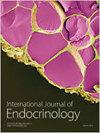Whether Detection of Gene Mutations Could Identify Low- or High-Risk Papillary Thyroid Microcarcinoma? Data from 393 Cases Using the Next-Generation Sequencing
IF 2.3
4区 医学
Q3 ENDOCRINOLOGY & METABOLISM
引用次数: 0
Abstract
Objective. The objective of this study is to explore the utilization of next-generation sequencing (NGS) technology in evaluating the likelihood of identifying individuals with papillary thyroid microcarcinoma (PTMC ≤10 mm) who are at high or low risk. Design. NGS was used to analyze 393 formalin-fixed, paraffin-embedded tissues of PTC tumors, all of which were smaller than 15 mm. Results. The study found that bilateralism, multifocality, intrathyroidal spread, and extrathyroidal extension were present in 84 (21.4%), 153 (38.9%), 16 (4.1%), and 54 (13.7%) cases, respectively. Metastasis of cervical lymph nodes was identified in 226 (57.5%) cases and 96 (24.4%) cases with CLNM >5. Out of the total number of cases studied, 8 cases (2.3%) showed signs of tumor recurrence, all of which were localized and regional. Genetic alterations were detected in 342 cases (87.0%), with 336 cases revealing single mutations and 6 cases manifesting compound mutations. 332 cases (84.5%) had BRAFV600E mutation, 2 cases had KRASQ61K mutation, 2 cases had NRASQ61R mutation, 8 cases had RET/PTC1 rearrangement, 3 cases had RET/PTC3 rearrangement, and 1 case had TERT promoter mutation. Additionally, six individuals harbored concurrent mutations in two genes. These mutations were of various types and combinations: BRAFV600E and NRASQ61R (n = 2), BRAFV600E and RET/PTC3 (n = 2), BRAFV600E and RET/PTC1 (n = 1), and BRAFV600E and TERT promoter (n = 1). The subsequent analysis did not uncover a significant distinction in the incidence of gene mutation or fusion between the cN0 and cN1 patient cohorts. The presence of BRAFV600E mutation and CLNM incidence rates were found to be positively correlated with larger tumor size in PTMC. Our data showed that gene mutations did not appear to have much to do with high-risk papillary thyroid microcarcinoma (PTMC). However, when we looked at tumor size, we found that if the tumor was at least 5 millimeters in size, there was a higher chance of it being at high risk for PTM (, odds ratio (OR) = 2.55, 95% confidence interval (CI): 1.57–4.14). Identification of BRAFV600E mutation was not demonstrated to be significantly correlated with advanced clinicopathological characteristics, although it was strongly associated with a bigger tumor diameter (OR = 4.92, 95% CI: 2.40–10.07, ). Conclusion. In clinical practice, BRAFV600E mutation does not consistently serve as an effective biomarker to distinguish high-risk PTMC or predict tumor progression. The size of the tumor has a significant correlation with its aggressive characteristics. PTMC with a diameter of ≤5 mm should be distinguished and targeted as a unique subset for specialized treatment.检测基因突变能否识别低危或高危甲状腺乳头状微癌?使用新一代测序技术分析393例病例的数据
研究目的本研究旨在探讨如何利用下一代测序(NGS)技术评估识别甲状腺乳头状微癌(PTMC ≤10 mm)高危或低危患者的可能性。设计。使用 NGS 分析 393 例福尔马林固定、石蜡包埋的 PTC 肿瘤组织,所有肿瘤均小于 15 毫米。结果研究发现,分别有 84 例(21.4%)、153 例(38.9%)、16 例(4.1%)和 54 例(13.7%)存在双侧性、多灶性、甲状腺内扩散和甲状腺外延伸。226例(57.5%)和96例(24.4%)CLNM >5发现有颈淋巴结转移。在所有研究病例中,有 8 例(2.3%)出现肿瘤复发迹象,均为局部和区域性复发。342个病例(87.0%)检测到基因突变,其中336个病例显示单突变,6个病例显示复合突变。332例(84.5%)有BRAFV600E突变,2例有KRASQ61K突变,2例有NRASQ61R突变,8例有RET/PTC1重排,3例有RET/PTC3重排,1例有TERT启动子突变。此外,有 6 人同时携带两个基因的突变。这些突变的类型和组合多种多样:BRAFV600E和NRASQ61R(2例)、BRAFV600E和RET/PTC3(2例)、BRAFV600E和RET/PTC1(1例)以及BRAFV600E和TERT启动子(1例)。随后的分析并未发现 cN0 和 cN1 患者群在基因突变或融合发生率上有明显差异。在PTMC中,BRAFV600E基因突变的存在和CLNM发病率与肿瘤大小呈正相关。我们的数据显示,基因突变与高风险甲状腺乳头状微癌(PTMC)似乎没有太大关系。然而,当我们研究肿瘤大小时,我们发现如果肿瘤大小至少为5毫米,那么它成为PTM高风险的几率就会更高(几率比(OR)=2.55,95%置信区间(CI):1.57-4.14)。BRAFV600E 基因突变与晚期临床病理特征无显著相关性,但与肿瘤直径较大密切相关(OR = 4.92,95% 置信区间:2.40-10.07)。结论在临床实践中,BRAFV600E突变并不能一直作为区分高风险PTMC或预测肿瘤进展的有效生物标志物。肿瘤大小与其侵袭性特征有显著相关性。应将直径≤5 毫米的 PTMC 作为一个独特的亚群加以区分并进行专门治疗。
本文章由计算机程序翻译,如有差异,请以英文原文为准。
求助全文
约1分钟内获得全文
求助全文
来源期刊

International Journal of Endocrinology
ENDOCRINOLOGY & METABOLISM-
CiteScore
5.20
自引率
0.00%
发文量
147
审稿时长
1 months
期刊介绍:
International Journal of Endocrinology is a peer-reviewed, Open Access journal that provides a forum for scientists and clinicians working in basic and translational research. The journal publishes original research articles, review articles, and clinical studies that provide insights into the endocrine system and its associated diseases at a genomic, molecular, biochemical and cellular level.
 求助内容:
求助内容: 应助结果提醒方式:
应助结果提醒方式:


